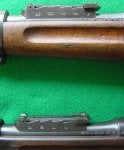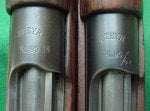Belgium, in the early 1920s, was refurbishing and converting to 7,9mm a lot of "Foreign rifles" for Sales to China ( I have several Gew98s from China with "Balle Blindee" and other Belgian (ELG) proof markings). There is also some credence in the fact that Belgium had large numbers of M91 Mosins which were converted to 7,9, either by Venus-Werke (1917) for Turkey, or by the Belgians themselves ( also for China...even though China had acquired large quantites of MN 91s from the new Soviet Russia, the design was accepted also in 7,9mm by some warlords, who already had Mausers ...
( which brings up the story of a Gun-runner scam involving MN rifles, the wrong ammo, and missing ( delayed) Bolts ( which way I can't remember)...The Chinese Warlord eventually got the Rifles, the bolts and the correct ammo, and the Gun-runner was fished out of the Huang-Pu River at Shanghai, minus his windpipe. ( and his money).)
The Belgians would have had access to quantities of MN rear sights of the old style, and many other various spares from all sorts of rifles; as they also used early style GEW 98 Trigger guards ( locking screw within Kingscrew head) for some of the China export refurb 98s ( I have two fitted with such). SO 1920s Liege was a thriving workshop of Milsurp refurbishment.
As mentioned, many "new" countries were clamouring for 7,9mm calibre rifles; Greece was one, as were Ethiopia and China. The Rifles could have been part of a "Greek" supply, early in the 1930s, along with the FN30 Mausers; or it could be that they were captured by the Germans ( either in Belgium, Greece or even Yugoslavia) subsequently captured by the British (where?) and issued to Greek troops which had escaped the German-Italian invasion of Greece and were fighting in North Africa?
Ethiopia seems unlikely a destination, as Italian use of the M95 and M88/90 ( all 8x50R) in the AOI makes no mention of captured
7,9 M88/24s at all (but then the variety of rifles used by the Abyssinians was mind-blowing).
Can the M88/24 rifles be dated by the Belgian proof and inspection marks which are quite evident???. Remember that Belgium also assembled "M94/24s", similar to the Yugo "M95.M" of domestic Yugo conversion.
Another Mystery awaiting a solution.
Regards, Doc AV
AV Ballistics.

























